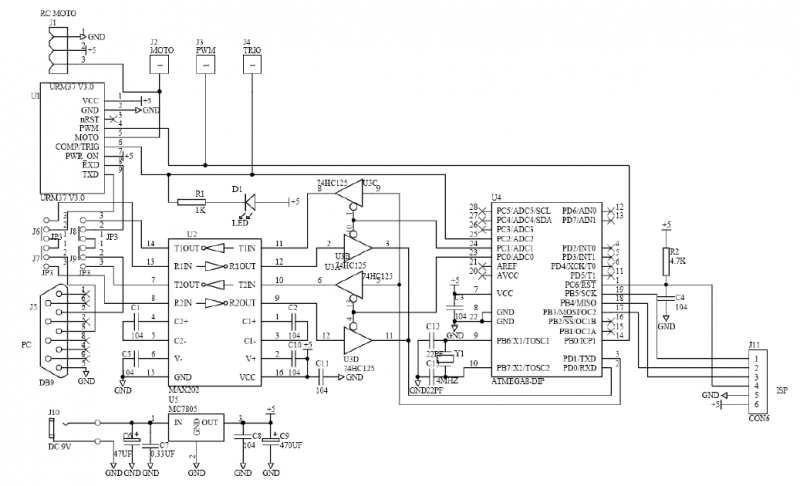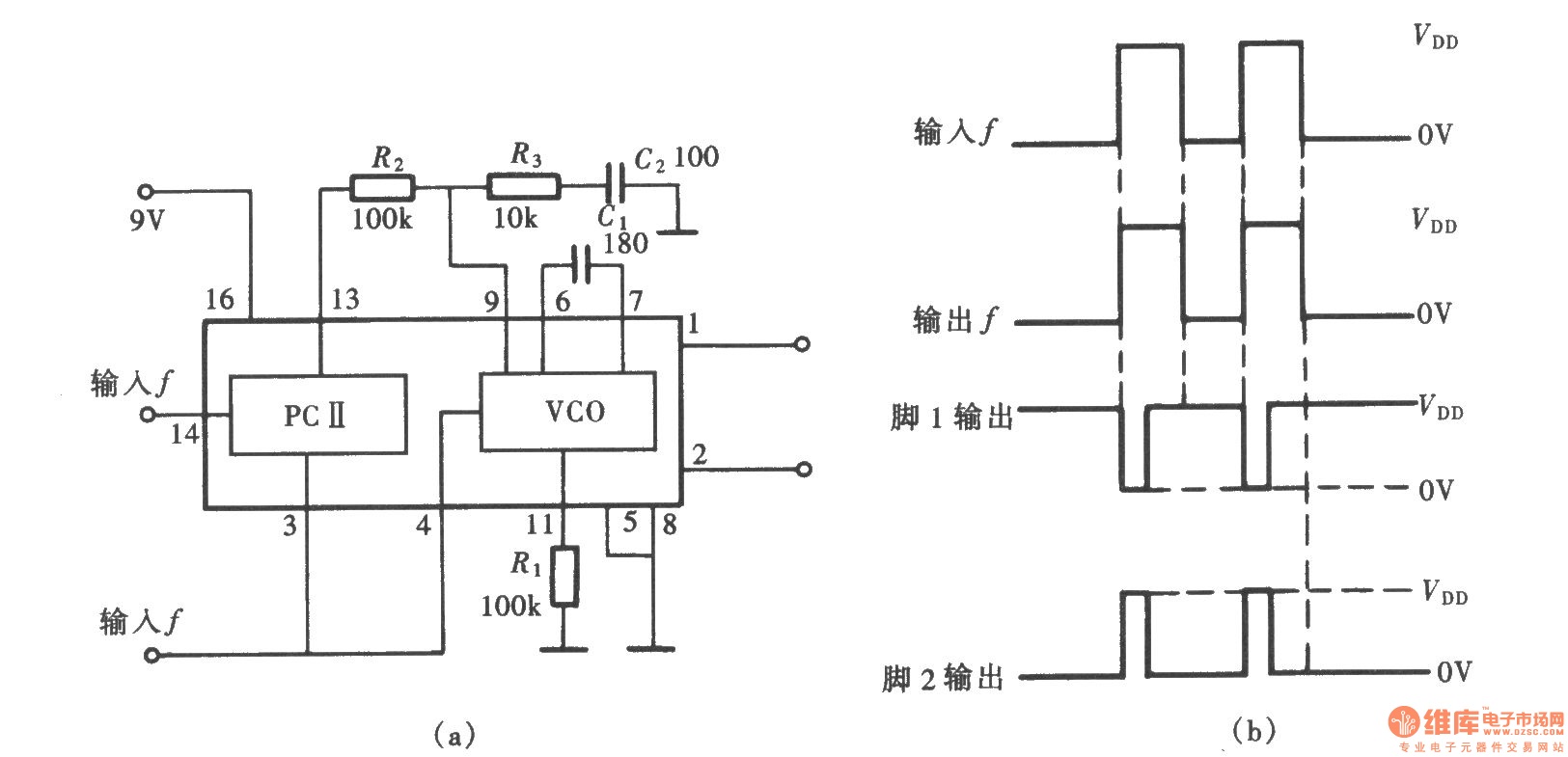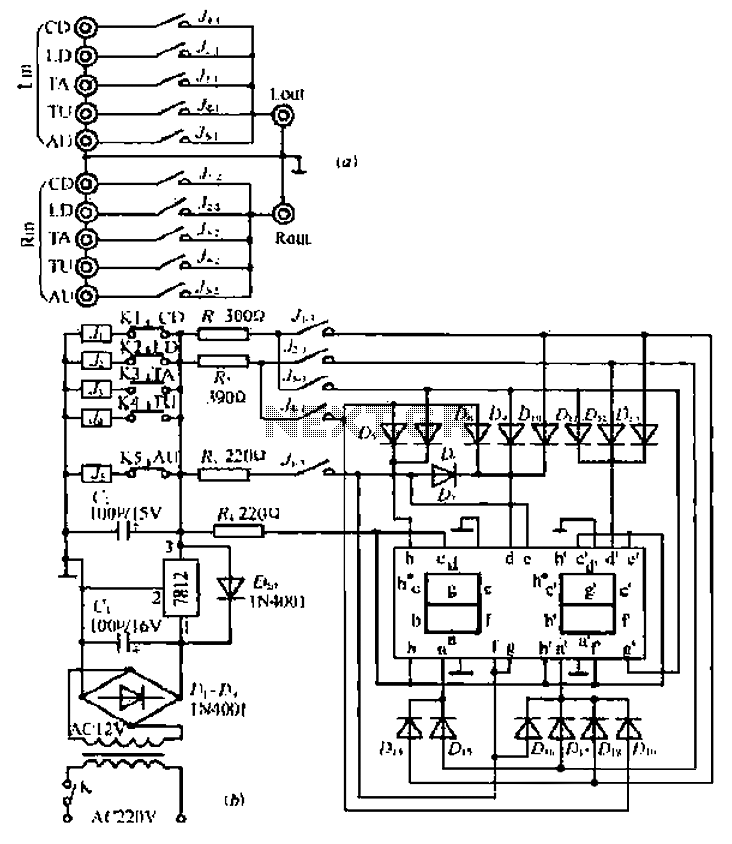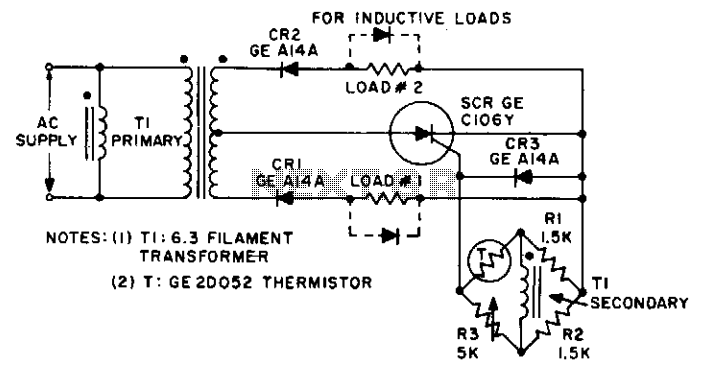
Generate Dual Voltages That Track By Percentage Of Range
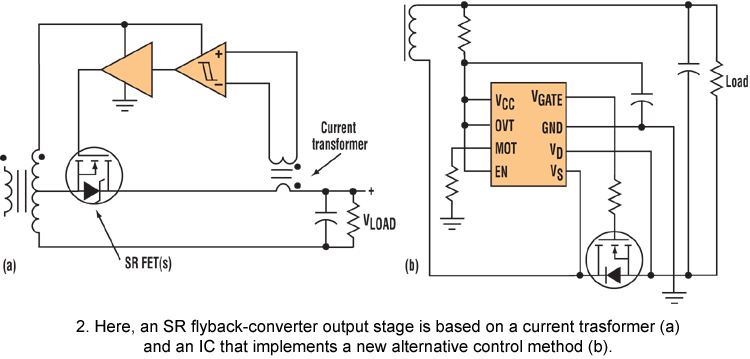
The objective is to vary two voltages, V1 and V2, by an equal percentage of their respective ranges (V1MAX - V1MIN and V2MAX - V2MIN), where V1MAX, V1MIN, V2MAX, and V2MIN are independent of one another. A common approach is to utilize ganged potentiometers; however, these are known to produce tracking errors of up to 5%. An alternative method employs a single potentiometer to generate two or more tracking voltages with an accuracy better than 0.5% of the range. The circuit features a square-wave oscillator using IC1a, which generates triangular waves across capacitor C1 that are fed into comparator IC1b. The potentiometer P1 adjusts the duty cycle of the output pulses from the comparator, ranging from 0% to 100%. Transistor Q1 and multiplexer switch IC2 transform the comparator output into pulses with well-defined edges, which are then directed to the digital control inputs of the analog multiplexer that processes V1MAX, V1MIN, V2MAX, and V2MIN as analog inputs. The multiplexer outputs are integrated by components R7-C2 and R8-C3, followed by buffering through IC1c and IC1d. The oscillator frequency is set to approximately 5 kHz, which is sufficient to minimize ripple in the integrator output while ensuring that the rise and fall times of the pulses are negligible relative to the pulse repetition period. It is important that capacitors C2 and C3 are of low-leakage types. This concept can be expanded to generate additional tracking voltages by incorporating more multiplexer switches, integrators, and buffers.
The described circuit effectively addresses the challenge of generating multiple tracking voltages with high accuracy. The use of a square-wave oscillator to create triangular waveforms allows for precise control over the output voltages. The choice of a single potentiometer to adjust the duty cycle is a significant improvement over traditional ganged potentiometers, reducing the likelihood of tracking errors. The integration of the output pulses ensures that the resulting voltages are smooth and stable, critical for applications requiring precise voltage control.
Transistor Q1 plays a pivotal role in shaping the output pulses, ensuring that the transitions are sharp and well-defined, which is essential for maintaining the integrity of the signals processed by the analog multiplexer. The multiplexer itself allows for the selection of different voltage levels, enabling the circuit to adapt to various requirements without the need for multiple independent potentiometers.
The design emphasizes the importance of component selection, particularly the use of low-leakage capacitors, which are vital for maintaining the accuracy of the integrator outputs. The specified frequency of 5 kHz strikes a balance between minimizing ripple and ensuring fast response times, making the circuit suitable for dynamic applications where voltage adjustments are frequently required.
Overall, this circuit exemplifies a robust solution for generating multiple tracking voltages with high precision, making it applicable in various electronic systems where voltage regulation is critical. The potential for expansion with additional components further enhances its versatility and utility in complex electronic designs.Consider the need to vary two voltages, V1 and V2, by an equal percentage of their ranges (V1MAX - V1MIN) and (V2MAX - V2MIN), with V1MAX, V1MIN, V2MAX, and V2MIN independent of each other. The first idea that comes to mind is to use ganged potentiometers (Fig. 1). However, ganged potentiometers are notorious for producing tracking errors as high as 5%. Here`s a simple method that uses a single potentiometer to generate two or more tracking voltages with an accuracy of better than 0. 5% of range (Fig. 2). The circuit around IC1a is a square-wave oscillator. Triangular waves across C1 are applied to comparator IC1b. Potentiometer P1 varies the duty cycle of the pulses at the comparator output from 0% to 100%. Transistor Q1 and the multiplexer switch IC2 convert the comparator output into pulses with well defined edges.
These pulses are applied to the digital control inputs of the analog multiplexer that receives V1MAX, V1MIN, V2MAX, and V2MIN as the analog inputs. The multiplexer outputs, which are integrated by components R7-C2 and R8-C3, are buffered by IC1c and IC1d.
The oscillator`s frequency is optimized to be about 5 kHz. This frequency is high enough to produce negligible ripple in the integrator output. At the same time, the frequency is low enough to ensure that rise and fall times of the pulses are negligible compared to the pulse repetition period. Note that capacitors C2 and C3 must be low-leakage types. This idea can be extended to generate more tracking voltages by using additional multiplexer switches, integrators, and buffers.
🔗 External reference
The described circuit effectively addresses the challenge of generating multiple tracking voltages with high accuracy. The use of a square-wave oscillator to create triangular waveforms allows for precise control over the output voltages. The choice of a single potentiometer to adjust the duty cycle is a significant improvement over traditional ganged potentiometers, reducing the likelihood of tracking errors. The integration of the output pulses ensures that the resulting voltages are smooth and stable, critical for applications requiring precise voltage control.
Transistor Q1 plays a pivotal role in shaping the output pulses, ensuring that the transitions are sharp and well-defined, which is essential for maintaining the integrity of the signals processed by the analog multiplexer. The multiplexer itself allows for the selection of different voltage levels, enabling the circuit to adapt to various requirements without the need for multiple independent potentiometers.
The design emphasizes the importance of component selection, particularly the use of low-leakage capacitors, which are vital for maintaining the accuracy of the integrator outputs. The specified frequency of 5 kHz strikes a balance between minimizing ripple and ensuring fast response times, making the circuit suitable for dynamic applications where voltage adjustments are frequently required.
Overall, this circuit exemplifies a robust solution for generating multiple tracking voltages with high precision, making it applicable in various electronic systems where voltage regulation is critical. The potential for expansion with additional components further enhances its versatility and utility in complex electronic designs.Consider the need to vary two voltages, V1 and V2, by an equal percentage of their ranges (V1MAX - V1MIN) and (V2MAX - V2MIN), with V1MAX, V1MIN, V2MAX, and V2MIN independent of each other. The first idea that comes to mind is to use ganged potentiometers (Fig. 1). However, ganged potentiometers are notorious for producing tracking errors as high as 5%. Here`s a simple method that uses a single potentiometer to generate two or more tracking voltages with an accuracy of better than 0. 5% of range (Fig. 2). The circuit around IC1a is a square-wave oscillator. Triangular waves across C1 are applied to comparator IC1b. Potentiometer P1 varies the duty cycle of the pulses at the comparator output from 0% to 100%. Transistor Q1 and the multiplexer switch IC2 convert the comparator output into pulses with well defined edges.
These pulses are applied to the digital control inputs of the analog multiplexer that receives V1MAX, V1MIN, V2MAX, and V2MIN as the analog inputs. The multiplexer outputs, which are integrated by components R7-C2 and R8-C3, are buffered by IC1c and IC1d.
The oscillator`s frequency is optimized to be about 5 kHz. This frequency is high enough to produce negligible ripple in the integrator output. At the same time, the frequency is low enough to ensure that rise and fall times of the pulses are negligible compared to the pulse repetition period. Note that capacitors C2 and C3 must be low-leakage types. This idea can be extended to generate more tracking voltages by using additional multiplexer switches, integrators, and buffers.
🔗 External reference


